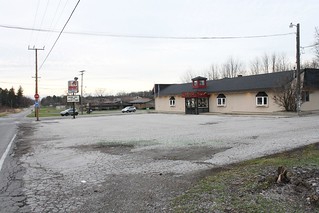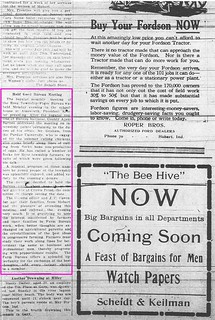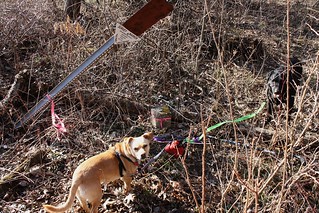We've seen the
Walter Bros. Garage before, but here's a slightly different view:
 (Click on images to enlarge)
(Click on images to enlarge)
So that would be the Lincoln Highway passing in front of the garage. It does not appear to be paved. I believe this photo dates to 1919 or earlier, based on the verso evidence:

We do see "1919" in what appears to be a postmark. But also, the message was written by someone named Paul who is linked somehow to a Lina or Lena, and a little Elmer; and in the
1920 Census, taken in February of that year, we find a nine-month-old boy named Elmer, the son of Paul Bourquin and his wife, Lena, who were farming rented land in Ross Township. (They also have a two-year-old son, Paul.) Paul Sr. and Lena were both natives of Switzerland whose mother tongue was French.
The message is written in German. Now, what little I know of that language, I learned against my will in grade school, so it's not surprising that I would have trouble reading the postcard message. But I think in this case the difficulty is not just my own ignorance — this doesn't seem to be the proper German we learn in school. I have no idea whether Paul is being playful by writing incorrectly, as
people sometimes do, or whether this is a regional dialect of German, or whether it's just the sort of German you might expect from a native French speaker.
Anyway, I've attempted a loose translation:
Hello there! (We) have received on Good Friday morning a healthy splendid little boy (Buebchen). Here it is Good Friday morning and we're as sound as turnips. All are doing well, all 4 are healthy and jolly. When you get married we will all quickly come across, so don't keep us waiting. When you get married, get over here right away so we won't be left suffering any longer. Lena wants to get little Elmer baptized. I hope you and all the rest are healthy, and my hearty greetings to all. Paul.
Perhaps some German-speaker will stumble across this post and help me out.
[Update: the corrected sentences are from Jon Casbon's comments to this post.]
I can't positively identify Paul in any official records other than the 1920 census. Nor can I find any mention of him in my newspaper notes … until August 1922:
 (Click on image to enlarge)
(Click on image to enlarge)
Hobart News 17 Aug. 1922.
To find a Goodrich farm meeting that description, we have to go all the way back to the
1891 Plat Book, where we find this parcel of land, shown on the
1908 Plat Map as belonging to Eli and Levi Boyd, owned by a Thomas Goodrich.
 (Click on image to enlarge)
(Click on image to enlarge)
This image from the 1908 Plat Map shows the Thomas Goodrich farm as shown in the 1891 Plat Book.
Now I have to stop and ask myself who Thomas Goodrich was.
Born 1826, died 1891, he was the father of
Charles Goodrich, whose family has been mentioned several times already in this blog. I can't find him in Ross Township any earlier than the
1870 Census, where he and his wife, Sarah, with their three children (
Anna, Levi P.,* and Charles), are farming in what seems to be roughly the vicinity of the "old Goodrich farm."
But to return to the Bourquins — that 1922 farm sale sounds as if they are getting ready to move, doesn't it? If so, I don't know where they went, any more than I know where they came from.
__________________
*Levi seems to have preferred his middle name, Perry, as evidenced by the census records and various newspaper items. I think Perry may have continued farming the old Goodrich land for some years after his father's death.




































